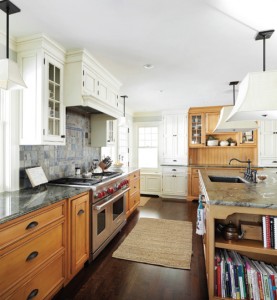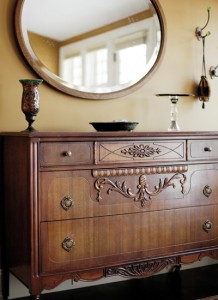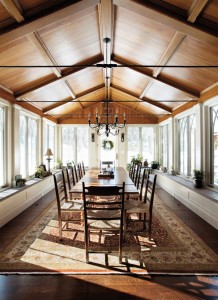After a long search for the perfect place to call home and enamored of a waterfront lot in Manchester-by-the-Sea, a couple takes extreme measures to raze an outdated house, building in its place their long-awaited dream home. By Regina Cole, Photographs by Bob O’Connor
“We moved a lot,” says Denise Lauzon. “We lived in a succession of beige houses all over the country.” The lack of color and character in her various domiciles did not bother Lauzon, she says, until she and her husband began to look for a permanent residence. Then she wanted to move into a house full of warmth and personality: a home.
“I grew up on the North Shore, so this is where we decided to settle,” she says. “We had no specific town in mind; we just wanted to be close to the ocean.” Close to the ocean is, indeed, where the family landed, but not until Lauzon and her husband almost gave up hope of ever finding what they wanted.
“We looked and looked; a realtor took us all over,” she recalls. “Nothing seemed right, until we came to this property overlooking the harbor in Manchester-by-the-Sea.”
Perched above the epicenter of the town’s picturesque harbor, the site she found so appealing combines a front-row view of the waterfront with the privacy of wooded seclusion. The beautiful location was ideal, but on it stood a ho-hum house dating to the mid-20th century. This spot, however, was so special that Lauzon and her husband never hesitated. They bought the lot, ugly house and all. Then they turned it over to Stephen Holt.
“We were so fortunate,” Lauzon says with a smile. “We got to know Steve because our children went to school together. When we bought this property, we didn’t interview lots of architectural firms; we knew he was reputable and local.”
 In Manchester-by-the-Sea, it doesn’t get more local that Holt. His family arrived here in 1626 and began building houses and boats; his great-grandfather’s firm, Roberts and Hoare, designed and built most of the Gilded Age summer estates on Boston’s North Shore. “They employed over 200 men.” Holt says. “The craftsmanship was beautiful, due in part to the area’s long tradition of shipbuilding and cabinetmaking.
In Manchester-by-the-Sea, it doesn’t get more local that Holt. His family arrived here in 1626 and began building houses and boats; his great-grandfather’s firm, Roberts and Hoare, designed and built most of the Gilded Age summer estates on Boston’s North Shore. “They employed over 200 men.” Holt says. “The craftsmanship was beautiful, due in part to the area’s long tradition of shipbuilding and cabinetmaking.
“This area became popular with wealthy Boston families,” he continues. “After the Civil War, they came for relief from the summer heat. This was an idyllic coastal setting in which to build their vacation homes.”
After graduating from Yale, Holt played a leading role in the restoration of Colonial Williamsburg. Today, he continues his historic preservation efforts from his office in a handsome Greek Revival temple at the center of town. He follows in his ancestors’ footsteps with contemporary Shingle-style cottages like the one he designed for the Lauzons. Anything but beige, the new house appears settled and venerable, growing organically from the granite ledge that reaches into Manchester Harbor.
“This is exactly what I wanted,” Lauzon says.
Before the 6,400-square-foot house could take root, though, the existing house had to go. “We let the fire department use it in a controlled burn,” Lauzon says. With the ground cleared, Holt’s favorite builder, Silva Brothers Construction, went to work. Millions of Americans know Silva Brothers Construction through watching “This Old House,” the PBS home improvement series now in its 32nd year. They might be pleased-or surprised-to learn that Tom Silva, the master contractor with the Boston accent, has a life beyond that of a TV star.
“Most of our work is not for ‘This Old House,'” says Charlie Silva, Tom’s nephew. “But we’re so associated with the series [that] it sometimes works against us. People think we’re too expensive.” Money wasn’t the issue with the Lauzon house. “The biggest challenge here was planning out the mechanics,” Silva explains. “There are endless considerations that affect everything else: where is the AC going on the second floor? Where will we vent the stove hood? There were miles and miles of wire and thousands of feet of pipe.” Of the basement nexus of the cables and pipes, he says, “It is like a nuclear sub when you walk into that room.”
 The high-tech systems are invisible in a house whose irregular massing and interior configurations could date to 1910. Holt’s design found inspiration in the historic evolution of New England architecture. “For the core, I imagined a little late-17th century house,” he says. “I didn’t want to dominate the harbor with a great big house. That’s why the design is not vertical, but linear.”
The high-tech systems are invisible in a house whose irregular massing and interior configurations could date to 1910. Holt’s design found inspiration in the historic evolution of New England architecture. “For the core, I imagined a little late-17th century house,” he says. “I didn’t want to dominate the harbor with a great big house. That’s why the design is not vertical, but linear.”
That core forms the traditional entry hall; late-17th century style is evident in raised paneling, Neoclassical proportions, and an arched entry leading into the kitchen and family rooms. This lovely room also serves as Lauzon’s home office, with machinery hidden behind Georgian paneling. “From there, Shingle-style wings radiate outward, as if they had been added over the years,” Holt explains. “It makes for an interesting interior, and it allowed us to break up the length of the house, so it wouldn’t feel like a bowling alley.”
The house boasts flooring made from quartersawn white oak, which is beautiful as it is functional. “It’s better with under-floor radiant heat,” says Silva. “There’s less movement, and it’s more up and down than sideways.” The Silva Brothers shop constructed the custom doors and staircases, made all the millwork, and clad the exterior, including the roof, with white cedar shingles. “It’s far more labor-intensive than an asphalt roof,” says Silva. “But vastly more beautiful. And it should last 40 to 50 years.”
On the ground floor, all hallways lead to an expansive kitchen, its counters and island surfaced with granite treated to an unusual leathered finish. Off the family room, an informal dining room is housed in a light-filled conservatory. With Gothic arches at the windows and a ceiling fashioned from reclaimed Southern long-leaf pine, the room is one of Holt’s tributes to Gilded Age architecture.
The linear design makes the view omnipresent, as each room looks out at the water. A broad veranda wraps around two sides of the house. Upstairs, each bedroom includes a small deck overlooking the harbor. In homage to the view, Lauzon chose a clear, light-blue color for the master bedroom walls. “I wanted to bring in the sea and the sky,” she says.
There are no beige rooms in this house; walls vary in color, from the blue of Lauzon’s bedroom to soft shades of pink, biscuit, and grayed green-blue. Wood tones dominate the cabinetry, window surrounds, moldings, floors, and a number of ceilings. Lauzon furnished the house with a mixture of new traditionally styled furniture and antiques. “I love to go antiquing, but am not partial to any one period or style. I like what’s pretty.”
Many rooms, including the kitchen and the parlor/home office, boast fireplaces. Some are constructed of sizeable granite boulders, their rounded shapes an echo of the granite ledge outside. Granite faces the poured concrete foundation and forms the base of the massive chimney.
Under the eaves at the top of the house, a surprise awaits in the form of a large pub. The woodsy room is lined with long-leaf pine and is furnished with a pool table, several TVs, a bar with beer taps, and comfortable lounging chairs drawn up to a fireplace at the room’s gable end. Cushioned seats fill the window niches; small Steve Holt-designed tables surrounded with Windsor chairs add to the pub atmosphere. Envisioned and designed by Holt as an afterthought, the room was an instant hit with the Lauzon family.
“It’s a gathering place for kids and adults,” says Lauzon. “We moved in in June 2010. When we had our first Thanksgiving here, we all ended up in the pub, and the evening ended at 3 a.m.”
Unlike homeowners who remember their house-building experience with a horror reserved for root canals, Lauzon loved every moment. “Steve is our first experience working with an architect,” she says. “A lot of people complain about dealing with a construction crew. For me, all of it was wonderful. It was hard seeing everyone go when we were done. We really bonded!” But Lauzon has found a way to maintain the bond.
“When we go away and my in-laws stay here, we give them Charlie’s number in case of emergencies. He knows the house,” Denise laughs. “And we get to stay in touch.”

